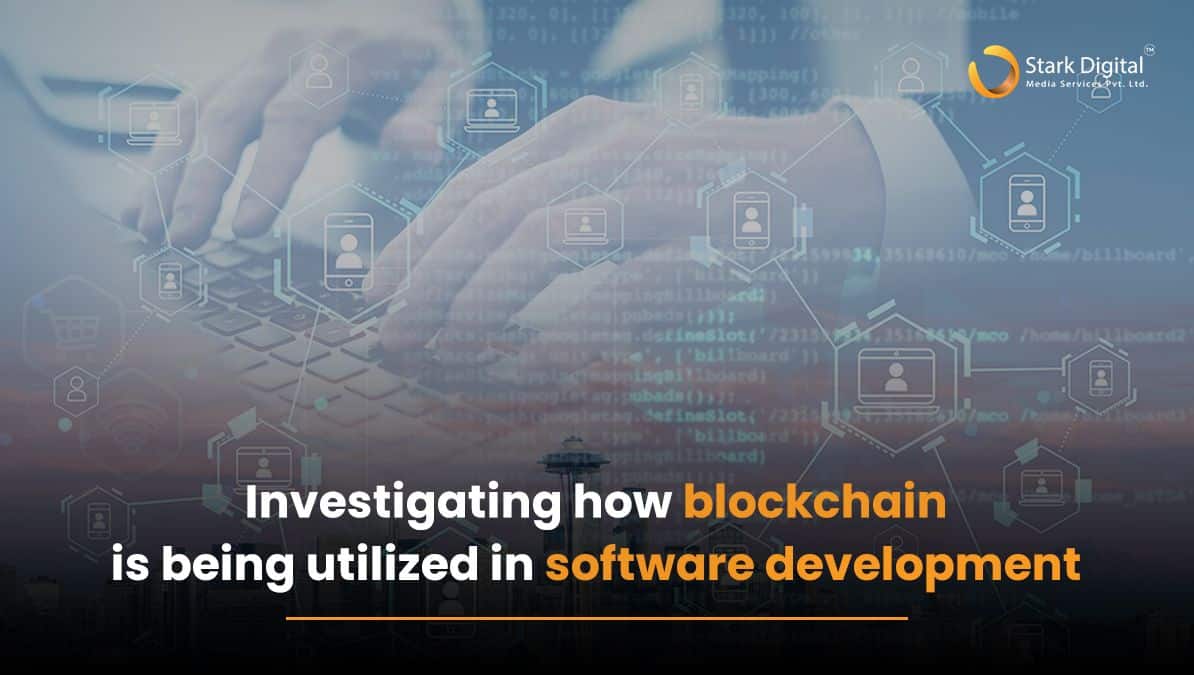Investigating how blockchain is being utilized in software development

Have you heard the name cryptocurrency, bitcoin?
If yes, then you must heard about the blockchain.
Blockchain has emerged as a revolutionary force, reshaping industries and challenging traditional paradigms. Beyond its initial association with cryptocurrencies, blockchain technology has found extensive applications in various domains, and one such field experiencing a transformative impact is software development. One of the major benefits is enhanced security.
Therefore, Many Application development company uses blockchain technology to enhance security majors.
Table of Contents
Understanding of Blockchain in Nutshell
Before delving into its applications, let’s briefly recap what blockchain is. At its core, a blockchain is a decentralized and distributed ledger that records transactions across a network of computers securely and transparently. Each transaction, or “block,” is linked to the previous one, forming an unchangeable “chain” of information. This architecture ensures immutability, transparency, and security- attributes that prove invaluable in the realm of software development.
In addition, blockchain technology allows for decentralized data storage, eliminating the need for a single centralized server to host data. This further reduces the risk of data breaches and provides greater security for organizations.
Why blockchain is so popular?
When you are transferring money online through Internet banking via an account number or phone number, once a transaction is completed, the bank updates the transaction record. Looking so simple process.
Well, most of us are aware that such types of transactions can be easily tampered with. This is the reason for the evolution of third-party payment applications. However, the main motive behind the creation of blockchain is this vulnerability.
Effective management of data and transactions is a pivotal aspect of business operations. Traditionally, organizations handle this information internally or delegate the task to third parties such as brokers, bankers, or lawyers, leading to increased time and costs. Thankfully, Blockchain emerges as a solution, streamlining the process and enabling swift transaction movement, ultimately saving both time and money.
Contrary to common misconception, Blockchain and Bitcoin are not interchangeable terms. While Blockchain is a versatile technology capable of supporting applications across various industries like finance, supply chain, and manufacturing, Bitcoin is a specific digital currency that relies on Blockchain for its security.
How to develop Blockchain?
Blockchains leverage encryption techniques to prevent data theft and tampering, making them particularly advantageous for applications demanding heightened security, such as financial services, supply chains, and healthcare industries.
The development process for blockchain software encompasses six key steps:
- Identify problems to solve with blockchains
Identify all problems that need to be solved with possible solutions. Make sure the solution will meet the demands of the business before starting from scratch to design an app and adapt the current solution to the blockchain.
- Select the blockchain infrastructure
Designing a blockchain-based app from scratch is a time-intensive process, often spanning months or even years. It necessitates thorough research to ensure that the final product aligns with your business requirements. Adequate time spent on research before initiating the app development ensures its efficacy in meeting your specific needs.
- Idea generation of blockchain
Choosing a blockchain platform involves defining business needs, generating creative ideas, and selecting technological elements for seamless development. Create a roadmap for timely execution and decide between permission or permissionless blockchain networks for simplified front-end programming and reliable outcomes.
- Proof-of-Concept:
To demonstrate the practicality of a blockchain project, a proof-of-concept is essential. Choose between a design prototype or a theoretical build-up, with theoretical cases supporting the latter. Proposals define project parameters, and once the theoretical phase is done, a prototype is created, including sketches, information architecture, mock-ups, designs, and tested goods.
- Technical and Visual Designs:
After designing the application, developers create user interfaces for each software component. APIs are integrated with user interfaces at the backend, while graphic designs enhance the application’s appearance. Once all console and UI designs are complete, the application is ready for development.
- Blockchain Software Development:
The pivotal stage involves creating and integrating APIs for use cases developed in various versions. After thorough testing, the blockchain application progresses to production, with deployment on a test network to ensure all features work as intended.
Types of blockchain in software development
- Public Blockchain:
Accessible to anyone without special authorization, a public blockchain is an open-source, reliable, and secure network. It allows universal participation, making it suitable for both developers and users.
- Private Blockchain:
Governed by a single entity, a private blockchain is tailored to a company’s internal network. It provides strengthened solutions for internal operations and networking.
- Hybrid Blockchain:
An innovative transformation, the hybrid blockchain combines features of both public and private blockchains. It offers businesses and governments improved operational solutions for more effective workflow management.
Benefits of blockchain in software development
- Decentralization:
Transactions are distributed across numerous machines, ensuring data integrity without relying on a central intermediary.
- Immutability:
Follows an append-only model, preventing unauthorized alterations or deletions of recorded data, and enhancing security.
- Transparency:
Offers visibility into transaction history through a distributed ledger accessible to all network users, verified by consensus.
- Enhanced Speed:
Streamlines and automates corporate procedures, enabling secure and quick transaction execution, with constant access to shared information.
- Traceability:
Improves traceability in supply chains, allowing tracking of products from origin to customer, enhancing credibility, efficiency, and safety.
- Lower Costs:
Eliminates the need for intermediaries, reducing costs by establishing trust through consensus, and providing everyone access to a verified immutable version.
Conclusion:
Blockchain technology is reshaping the landscape of software development by introducing enhanced security measures, decentralized version control, smart contract automation, and immutable record-keeping. As the industry continues to explore and adopt blockchain solutions, developers and organizations alike are poised to experience a paradigm shift in the way software is conceived, built, and maintained.
The integration of blockchain into software development processes not only fortifies security but also fosters a collaborative and transparent ecosystem that is vital for the future of the industry.
